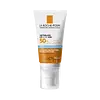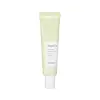What's inside
What's inside
 Key Ingredients
Key Ingredients

 Benefits
Benefits

 Concerns
Concerns

 Ingredients Side-by-side
Ingredients Side-by-side

Water
Skin ConditioningDiisopropyl Sebacate
EmollientAlcohol Denat.
AntimicrobialEthylhexyl Salicylate
UV AbsorberEthylhexyl Triazone
UV AbsorberBis-Ethylhexyloxyphenol Methoxyphenyl Triazine
Skin ConditioningDiisopropyl Adipate
EmollientPEG-8
HumectantDipropylene Glycol
HumectantC12-22 Alkyl Acrylate/Hydroxyethylacrylate Copolymer
StabilisingGlycerin
HumectantDrometrizole Trisiloxane
UV AbsorberAluminum Starch Octenylsuccinate
AbsorbentButyl Methoxydibenzoylmethane
UV AbsorberMethoxypropylamino Cyclohexenylidene Ethoxyethylcyanoacetate
StabilisingSilica
AbrasiveTocopherol
AntioxidantDiethylamino Hydroxybenzoyl Hexyl Benzoate
UV FilterAcrylates Copolymer
Acrylates/C10-30 Alkyl Acrylate Crosspolymer
Emulsion StabilisingCaprylyl Glycol
EmollientHydroxyacetophenone
AntioxidantPentaerythrityl Tetra-Di-T-Butyl Hydroxyhydrocinnamate
AntioxidantSodium Polyacrylate
AbsorbentTerephthalylidene Dicamphor Sulfonic Acid
UV AbsorberTriethanolamine
BufferingTrisodium Ethylenediamine Disuccinate
Water, Diisopropyl Sebacate, Alcohol Denat., Ethylhexyl Salicylate, Ethylhexyl Triazone, Bis-Ethylhexyloxyphenol Methoxyphenyl Triazine, Diisopropyl Adipate, PEG-8, Dipropylene Glycol, C12-22 Alkyl Acrylate/Hydroxyethylacrylate Copolymer, Glycerin, Drometrizole Trisiloxane, Aluminum Starch Octenylsuccinate, Butyl Methoxydibenzoylmethane, Methoxypropylamino Cyclohexenylidene Ethoxyethylcyanoacetate, Silica, Tocopherol, Diethylamino Hydroxybenzoyl Hexyl Benzoate, Acrylates Copolymer, Acrylates/C10-30 Alkyl Acrylate Crosspolymer, Caprylyl Glycol, Hydroxyacetophenone, Pentaerythrityl Tetra-Di-T-Butyl Hydroxyhydrocinnamate, Sodium Polyacrylate, Terephthalylidene Dicamphor Sulfonic Acid, Triethanolamine, Trisodium Ethylenediamine Disuccinate
Water
Skin ConditioningCyclomethicone
EmollientZinc Oxide
Cosmetic ColorantButyloctyl Salicylate
Skin ConditioningPolyglyceryl-3 Polydimethylsiloxyethyl Dimethicone
Skin ConditioningIsododecane
EmollientCI 77891
Cosmetic ColorantButylene Glycol
HumectantCaprylyl Methicone
Skin ConditioningGlycerin
HumectantIsononyl Isononanoate
EmollientPolymethylsilsesquioxane
1,2-Hexanediol
Skin ConditioningTribehenin
EmollientDisteardimonium Hectorite
StabilisingSorbitan Sesquioleate
EmulsifyingMica
Cosmetic ColorantMagnesium Sulfate
Triethoxycaprylylsilane
Aluminum Hydroxide
EmollientStearic Acid
CleansingSalvia Sclarea Oil
MaskingPropylene Carbonate
SolventCentella Asiatica Extract
CleansingChamomilla Recutita Flower Extract
MaskingEthylhexylglycerin
Skin ConditioningGlyceryl Caprylate
EmollientTrihydroxystearin
Skin ConditioningDisodium EDTA
Dipropylene Glycol
HumectantMaltodextrin
AbsorbentMoringa Oleifera Seed Extract
Skin ConditioningSodium Palmitoyl Proline
Skin ConditioningSnail Secretion Filtrate
Skin ConditioningArtemisia Capillaris Extract
Water, Cyclomethicone, Zinc Oxide, Butyloctyl Salicylate, Polyglyceryl-3 Polydimethylsiloxyethyl Dimethicone, Isododecane, CI 77891, Butylene Glycol, Caprylyl Methicone, Glycerin, Isononyl Isononanoate, Polymethylsilsesquioxane, 1,2-Hexanediol, Tribehenin, Disteardimonium Hectorite, Sorbitan Sesquioleate, Mica, Magnesium Sulfate, Triethoxycaprylylsilane, Aluminum Hydroxide, Stearic Acid, Salvia Sclarea Oil, Propylene Carbonate, Centella Asiatica Extract, Chamomilla Recutita Flower Extract, Ethylhexylglycerin, Glyceryl Caprylate, Trihydroxystearin, Disodium EDTA, Dipropylene Glycol, Maltodextrin, Moringa Oleifera Seed Extract, Sodium Palmitoyl Proline, Snail Secretion Filtrate, Artemisia Capillaris Extract
 Reviews
Reviews

Ingredients Explained
These ingredients are found in both products.
Ingredients higher up in an ingredient list are typically present in a larger amount.
Dipropylene Glycol is a synthetically created humectant, stabilizer, and solvent.
This ingredient helps:
Dipropylene glycol is technically an alcohol, but it belongs to the glycol family (often considered part of the ‘good’ alcohols). This means it is hydrating and gentle on skin unlike drying solvent alcohols like denatured alcohol.
As a masking agent, Dipropylene Glycol can be used to cover the smell of other ingredients. However, it does not have a scent.
Studies show Dipropylene Glycol is considered safe to use in skincare.
Learn more about Dipropylene GlycolGlycerin is already naturally found in your skin. It helps moisturize and protect your skin.
A study from 2016 found glycerin to be more effective as a humectant than AHAs and hyaluronic acid.
As a humectant, it helps the skin stay hydrated by pulling moisture to your skin. The low molecular weight of glycerin allows it to pull moisture into the deeper layers of your skin.
Hydrated skin improves your skin barrier; Your skin barrier helps protect against irritants and bacteria.
Glycerin has also been found to have antimicrobial and antiviral properties. Due to these properties, glycerin is often used in wound and burn treatments.
In cosmetics, glycerin is usually derived from plants such as soybean or palm. However, it can also be sourced from animals, such as tallow or animal fat.
This ingredient is organic, colorless, odorless, and non-toxic.
Glycerin is the name for this ingredient in American English. British English uses Glycerol/Glycerine.
Learn more about GlycerinWater. It's the most common cosmetic ingredient of all. You'll usually see it at the top of ingredient lists, meaning that it makes up the largest part of the product.
So why is it so popular? Water most often acts as a solvent - this means that it helps dissolve other ingredients into the formulation.
You'll also recognize water as that liquid we all need to stay alive. If you see this, drink a glass of water. Stay hydrated!
Learn more about Water